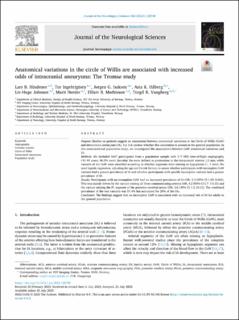| dc.contributor.author | Hindenes, Lars Bakke | |
| dc.contributor.author | Ingebrigtsen, Tor | |
| dc.contributor.author | Isaksen, Jørgen Gjernes | |
| dc.contributor.author | Håberg, Asta | |
| dc.contributor.author | Johnsen, Liv-Hege | |
| dc.contributor.author | Herder, Marit | |
| dc.contributor.author | Mathiesen, Ellisiv B. | |
| dc.contributor.author | Vangberg, Torgil Riise | |
| dc.date.accessioned | 2023-09-12T05:37:26Z | |
| dc.date.available | 2023-09-12T05:37:26Z | |
| dc.date.created | 2023-08-29T12:35:18Z | |
| dc.date.issued | 2023 | |
| dc.identifier.citation | Journal of the Neurological Sciences. 2023, 452 . | en_US |
| dc.identifier.issn | 0022-510X | |
| dc.identifier.uri | https://hdl.handle.net/11250/3088740 | |
| dc.description.abstract | Purpose
Studies on patients suggest an association between anatomical variations in the Circle of Willis (CoW) and intracranial aneurysms (IA), but it is unclear whether this association is present in the general population. In this cross-sectional population study, we investigated the associations between CoW anatomical variations and IA.
Methods
We included 1667 participants from a population sample with 3 T MRI time-of-flight angiography (40–84 years, 46.5% men). Saccular IAs were defined as protrusions in the intracranial arteries ≥2 mm, while variants of the CoW were classified according to whether segments were missing or hypoplastic (< 1 mm). We used logistic regression, adjusting for age and IA risk factors, to assess whether participants with incomplete CoW variants had a greater prevalence of IA and whether participants with specific incomplete variants had a greater prevalence of IA.
Results
Participants with an incomplete CoW had an increased prevalence of IA (OR, 2.3 [95% CI 1.05–5.04]). This was mainly driven by the variant missing all three communicating arteries (OR, 4.2 [95% CI 1.7–1 0.3]) and the variant missing the P1 segment of the posterior cerebral artery (OR, 3.6 [95% CI 1.2–10.1]). The combined prevalence of the two variants was 15.4% but accounted for 28% of the IAs.
Conclusion
The findings suggest that an incomplete CoW is associated with an increased risk of IA for adults in the general population. | en_US |
| dc.language.iso | eng | en_US |
| dc.rights | Attribution-NonCommercial-NoDerivatives 4.0 Internasjonal | * |
| dc.rights.uri | http://creativecommons.org/licenses/by-nc-nd/4.0/deed.no | * |
| dc.title | Anatomical variations in the circle of Willis are associated with increased odds of intracranial aneurysms: The Tromsø study | en_US |
| dc.title.alternative | Anatomical variations in the circle of Willis are associated with increased odds of intracranial aneurysms: The Tromsø study | en_US |
| dc.type | Peer reviewed | en_US |
| dc.type | Journal article | en_US |
| dc.description.version | publishedVersion | en_US |
| dc.source.pagenumber | 0 | en_US |
| dc.source.volume | 452 | en_US |
| dc.source.journal | Journal of the Neurological Sciences | en_US |
| dc.identifier.doi | 10.1016/j.jns.2023.120740 | |
| dc.identifier.cristin | 2170558 | |
| cristin.ispublished | true | |
| cristin.fulltext | original | |
| cristin.qualitycode | 1 | |

